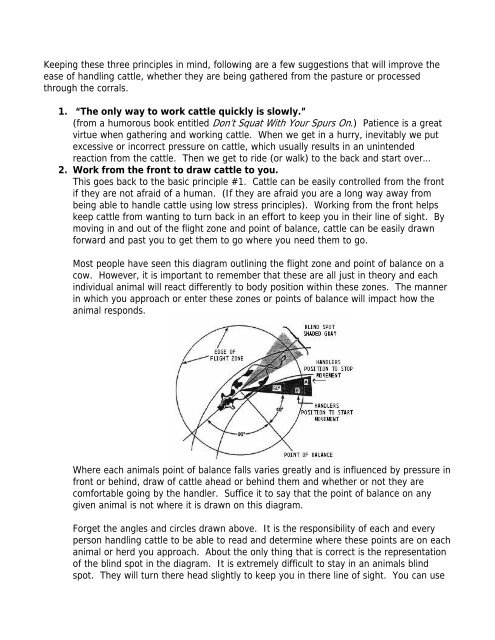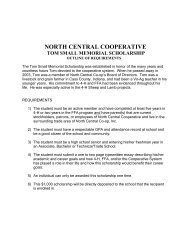Cattle Handling Pointers
Cattle Handling Pointers
Cattle Handling Pointers
You also want an ePaper? Increase the reach of your titles
YUMPU automatically turns print PDFs into web optimized ePapers that Google loves.
Keeping these three principles in mind, following are a few suggestions that will improve the<br />
ease of handling cattle, whether they are being gathered from the pasture or processed<br />
through the corrals.<br />
1. “The only way to work cattle quickly is slowly.”<br />
(from a humorous book entitled Don’t Squat With Your Spurs On.) Patience is a great<br />
virtue when gathering and working cattle. When we get in a hurry, inevitably we put<br />
excessive or incorrect pressure on cattle, which usually results in an unintended<br />
reaction from the cattle. Then we get to ride (or walk) to the back and start over…<br />
2. Work from the front to draw cattle to you.<br />
This goes back to the basic principle #1. <strong>Cattle</strong> can be easily controlled from the front<br />
if they are not afraid of a human. (If they are afraid you are a long way away from<br />
being able to handle cattle using low stress principles). Working from the front helps<br />
keep cattle from wanting to turn back in an effort to keep you in their line of sight. By<br />
moving in and out of the flight zone and point of balance, cattle can be easily drawn<br />
forward and past you to get them to go where you need them to go.<br />
Most people have seen this diagram outlining the flight zone and point of balance on a<br />
cow. However, it is important to remember that these are all just in theory and each<br />
individual animal will react differently to body position within these zones. The manner<br />
in which you approach or enter these zones or points of balance will impact how the<br />
animal responds.<br />
Where each animals point of balance falls varies greatly and is influenced by pressure in<br />
front or behind, draw of cattle ahead or behind them and whether or not they are<br />
comfortable going by the handler. Suffice it to say that the point of balance on any<br />
given animal is not where it is drawn on this diagram.<br />
Forget the angles and circles drawn above. It is the responsibility of each and every<br />
person handling cattle to be able to read and determine where these points are on each<br />
animal or herd you approach. About the only thing that is correct is the representation<br />
of the blind spot in the diagram. It is extremely difficult to stay in an animals blind<br />
spot. They will turn there head slightly to keep you in there line of sight. You can use



